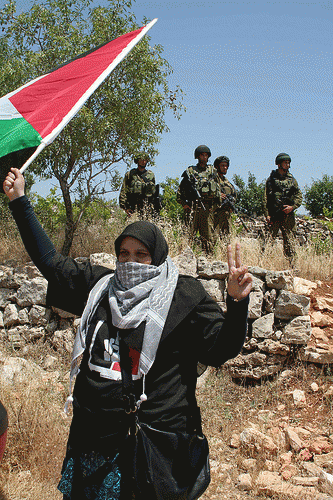To start, we insisted that Israel was a theocracy. Some objected saying no, it is a democracy. We pointed out so is Iran, and further, the Founders had in our own history, the theocratic seventeenth-century Massachusetts Bay Colony and its democratic trappings. We can also point out that Israel has no constitution and never had one. Its fundamental laws are what are passed by the Knesset, its parliament, which could change all at a moment's notice. Its current basic laws support the continued majority Jewish power in the country indefinitely, making and enforcing the laws of the country. The minority rights in religious matters are merely those of sufferance, and can be withdrawn by the majority at any time, or denied, as the Israelis have continuously done with the property rights of Islamic and Christian Arabs. But even though Israel is an obvious theocracy, that need not be proved to deny congressional military aid to Israel, under the Establishment Clause of the First Amendment. Israeli laws, like the discriminatory Right-to-Return law that does not extend to former Arab inhabitants of Palestine or their descendants, and its action in government-supported encroachments by settlements and protection of settlers in Arab lands by its armed forces, equally clearly bar Israel from any claim to U.S. taxpayers' money.
Israeli settlements are Jewish Israeli civilian communities built on lands occupied by Israel since the 1967 Six-Day War, and currently exist in the West Bank, East Jerusalem, and in the Golan Heights. Government spending per citizen in the Jewish settlements is double that spent per Israeli citizen in Tel Aviv and Jerusalem, while government spending for settlers in isolated areas is three times the Israeli national average. Most of the spending goes to the security of the citizens living there. On 30 June 2014, according to the Yesha Council, 382,031 Jewish settlers lived in the 121 officially recognized settlements in the West Bank, over 300,000 Israelis lived in settlements in East Jerusalem and over 20,000 lived in settlements in the Golan Heights. In January 2015 the Israeli Interior Ministry gave figures of 389,250 Israelis living in the West Bank and a further 375,000 Israelis living in East Jerusalem.
Many settlements began as military outposts and were later expanded and populated with civilian inhabitants. According to a secret document dating to 1970, obtained by Haaretz, the settlement of Kiryat Arba was established by confiscating land by military order and falsely representing the project as being strictly for military use while, in reality, Kiryat Arba was planned for settler use. The method of confiscating land by military order for establishing civilian settlements was an open secret in Israel throughout the 1970s, but publication of the information was suppressed by the military censor.
Since 1967, government-funded settlement projects in the West Bank are implemented by the "Settlement Division" of a sympathetic NGO that is funded by the Israeli government and leases lands from the Civil Administration to settle in the West Bank. It is authorized to create settlements in the West Bank on lands licensed to it by the Civil Administration. At least some hundred unauthorized outposts were established since 2002 with state funding in the 60% of the West Bank that was not under Palestinian administrative control. The population growth of settlers did not diminish. In 2011, Haaretz revealed the Civil Administration's "Blue Line"-plan, written in January 2011, which aimed to increase Israeli "state-ownership" of West Bank lands ("state lands") and settlement in strategic areas like the Jordan Valley and the Palestinian northern Dead Sea area. In March 2012, it was revealed that the Civil Administration over the years covertly allotted 10% of the West Bank for further settlement. Provisional names for future new settlements or settlement expansions were already assigned. The plan includes many Palestinian built-up sites in the Areas.
The actual buildings of the Israeli settlements cover only 1 percent of the West Bank, but their jurisdiction and their regional councils extend to about 42 percent of the West Bank, according to the Israeli NGO B'Tselem. Yesha Council chairman Dani Dayan disputes the figures. Between 2001 and 2007 more than 10,000 Israeli settlement units were built, while 91 permits were issued for Palestinian construction, and 1,663 Palestinian structures were demolished in one area.
West Bank Palestinians have their cases tried in Israel's military courts while Jewish Israeli settlers living in the same occupied territory are tried in civil courts, an arrangement has been described as "de facto segregation" by the UN Committee on the Elimination of Racial Discrimination. Evidence of religious discrimination by Israel, enforced by armed IDF oppression supported by U.S. aid, is incredibly clear.






